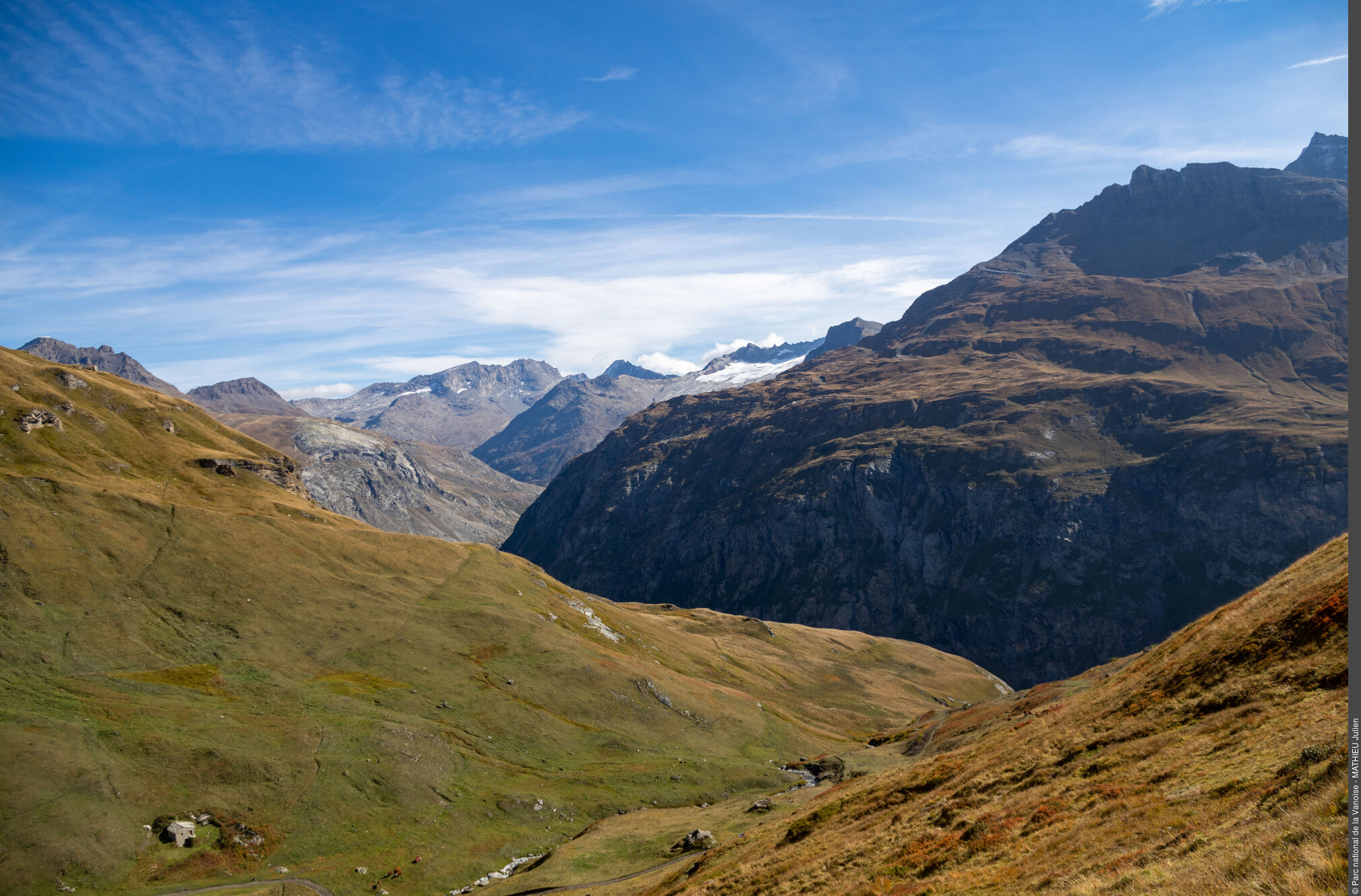
Vallon de Bessans
If I like to roam through the valley of Bessans, it is first and foremost because this place knows how to satisfy an insatiable love for nature. It is the delicate whistling of the wind in the feathers of the bearded vulture, the powerful scent of the plants on the adrets that accompany you as you climb, and the touching sight of the young ibex, the future of a species at one time almost extinct, that rewards you when you reach the valley. But much richer still is the path which recounts the long history of those bygone men who lived on the mountain, and the more recent account of those who try to preserve it... A valley nestled between culture and nature, well known as home to the Haute-Maurienne. Benoit Deffrennes, Vanoise National Park ranger
Description
From the car park, cross the Arc river over the bridge and take the road leading to the hamlet. At the wash house, follow the lane on the right which leads to a dirt track. Follow this track over three bends, then take the trail on the left. Towards an altitude of 1,950 m at the locality of ""Le Cloton"" the trail joins the GR5. Continue on the trail that crosses the bends of the agricultural track. Towards an altitude of 2,200 m, the trail joins the track again at the level of a single mountain pasture chalet. From this point, follow the track which forms two small bends before levelling out, until descending slightly to the level of the valley. Pass the torrent by the bridge and then go back down into the valley on the left, still on the agricultural track, until the last mountain chalet. The return journey follows the same path.
"- Departure : Car park, Le Villaron, Bessans
- Arrival : Car park, Le Villaron, Bessans
- Towns crossed : BESSANS
Forecast
Altimetric profile
Recommandations
Standard recommendations for the mountain.
Information desks
Transport
Access and parking
Parking :
Accessibility
No
- Emergency number :
- 114
10 points of interest
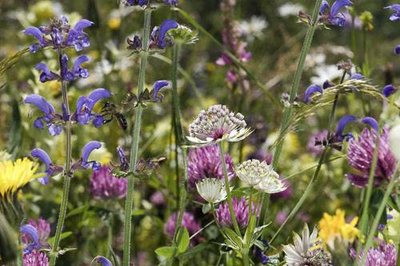
Détail de quelques espèces de fleurs d'une prairie de fauche. - PNV - STORCK Frantz  Pastoralism
PastoralismThe hay meadows
Bistort, common sage, sainfoin, rhinanthus, geranium are some of the names and colours among the fifty species of plants that may be present in mountain hay meadows. Look at this floral carpet submerging the hamlet of Villaron under a colourful sea. The meadows, harvested once a year, serve primarily as larders for livestock in the winter, but also as a postcard image for the hiker and as a garden of Eden for the naturalist. Some of the more adventurous flowers carry on along the first few steps of the trail.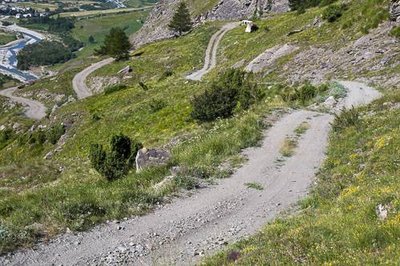
Piste du Vallon, au-dessus de Bessans. - PNV - AUGÉ Vincent  Pastoralism
PastoralismThe adrets
The effort has begun, and you gradually climb the sloping mountain. These southern slopes, the adrets, receive the full force of the sun’s rays: a small tip of the Mediterranean in the frozen mountain. This is the habitat of plants that thrive in dry and sunny environments, such as wormwood and European feather grass, and a protected butterfly, the Apollo, recognisable by the red eyespots on its white wings. Ÿou will also see that it is the favourite place of bygone sheep or cattle farmers. In the absence of grazing, these habitats are threatened with being covered with junipers.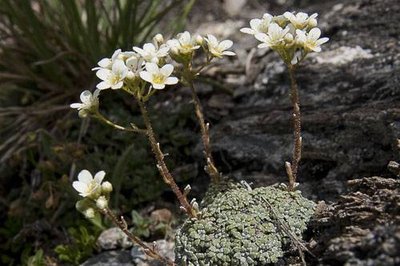
La saxifrage vaudoise. - PNV - DEFFRENNES Benoît  Flora
FloraSaxifraga valdensis
"Try to find this rare flower under the shelter of a large rock. This well-named plant, which ""breaks up rock,"" is lodged in the rock crevices. And not just any! This very rare protected plant can only be found in France in some localities of the Hautes-Alpes, and only in Bessans in the department of Savoy. So come and admire the rarity of these grey-blue lanceolate leaves grouped into flattened pads. If you are here in July, a panicle of beautiful and immaculate delicate flowers will spring up for you."
Gravure rupestre au Cloton. - PNV - GROSSET Félix  Small heritage
Small heritageEngraved stones
"Ÿou are now midway through your endeavour. Stop for a breather - have you noticed the engravings made by the farmers on the rock face to your left? Here on the adrets, the rocky slope and dry flora offer but few opportunities for greedy dairy cows. By contrast, it is well suited to sheep and goats, which is why the young shepherds and shepherdesses spent their days here watching over their flocks. The summer days are long, so they sometimes became bored. Deprived of the sacrosanct ""smartphone"", they used their imagination to mark the rock with names, dates and small drawings. As you descend, you can stop in front of the first bend in the track after the barrier of Cloton. This was the moor of the shepherds, a meeting place, and you will see beautiful drawings of cows, hunters and of mountains..."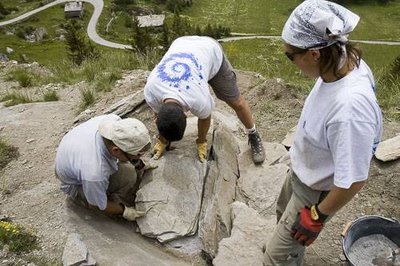
Entretien de sentier lors du stage ouvriers au collet de la Madeleine. - PNV - BASSARGETTE Denis  Water
WaterThunderstorms: Water versus the trails
"Ÿour path borders a dried-up stream. The least that can be said is that this stream is lifeless, dormant, and without the slightest drop of water to tinkle over the rocks. However, the violent summer thunderstorms in 2013 re-awakened the torrent causing it to burst its banks, taking with it the path you are on, going so far as to barricading the agricultural track with the stones that it transported. The national park’s team of workers and rangers restored the portion of the trail and created a ""dyke"" to curb its stormy fervour. This fight against the ravaging water is the same for all trails of the national park which must be regularly maintained and remodelled at the expense of much elbow grease!"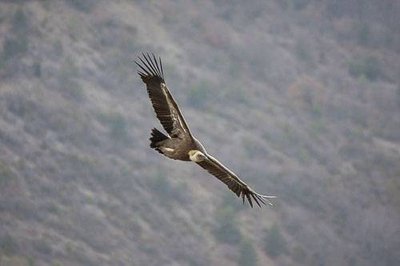
Jeune vautour fauve en vol. - PNV - DEFFRENNES Benoît  Fauna
FaunaBirds of prey
Stop awhile to gaze upon the cliffs of the Pis and the face of the Croix de Dom Jean Maurice that stands above you. This is the place to see the magnificent birds of prey cruising through the skies, finding rising air currents to help them soar. The griffon vultures are plentiful here and like you, come to Bessans for their summer holiday, choosing this site as their night-time gîte. The golden eagle is commonly found in search of reckless marmots and the bearded vulture, the great orange-bodied glider, regularly flies past since it nests not far away. It is a great chance to observe the bearded vulture as it is the rarest bird of prey in Europe!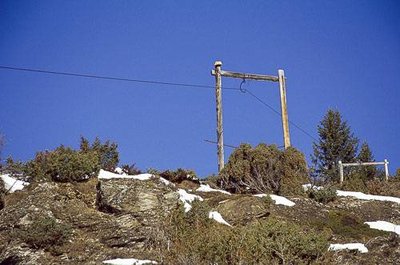
Portique supportant un ancien câble à foin au milieu de genévriers. Vue vers N. - PNV - HÉMERAY Damien  Know-how
Know-howThe hay cable
"In front of you, a metal hoop planted at the top of the slope briefly draws your attention. Félix Grosset, a Bessans native and former ranger of the National park knows how to revive this innocuous frame... Bright-eyed, he tells us how, together with his father, he lowered the bales of hay down to the valley, thanks to the cable which stretches from this hoop to the bottom. Mere child’s play thanks to this technique imported from neighbouring Italy in the 1920s. Prior to this cable, a ""harneis"" was used, a sort of sled that contained the ""bouisson"" or more than 300 kg of hay which had to be held back during its conveyance down the slope on a man’s back. As for the cable, it was towards the end of the fifties on a beautiful autumn day that the familiar whistling of the ""hay zip-line"" last resounded as it came to expressly deliver the winter sustenance of the Bessans cows."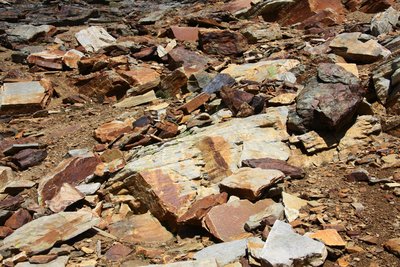
Roches ferreuses non loin de la mine du col du Carro. - PNV - DEFFRENNES Benoît  Archaeology
ArchaeologyThe Mâchefer mine
Place names can often tell us about the history of a place. Here at Mâchefer, stop below the track to see an old mine. Although the rock is ferrous here, as the name suggests, it is pyrite that was sought during the Bronze Age and even more so in Roman times. Upstream of the track, a red slab is carved with large circles, solar rings, and Celtic crosses, recognisable by their four equal arms. These engravings made between 500 BC and the Gallo-Roman period are perhaps linked to mining, where the divine bolts of lightning happily came to cross swords...
Chalets du Vallon, commune de Bessans. Au fd., le Glacier de Méan Martin. Vue vers NO. - PNV - JOURDAN Jérémie  Architecture
ArchitectureThe alpine chalets
Even faced with the majestic valley of Bessans, you cannot ignore the little bits of rocks that are the chalets. These rocks date back to the 17th and 18th century, built with the most obvious material in this landscape, stone. Wood, which is rarer still, is reserved for the framework. The large schist slabs of lauze serve as tiles and the outer wall is covered with lime. Today, maintained and restored according to Bessanais tradition, it was once the holiday destination and summer pasture for women, children, cows and chickens, cats and dogs, all of whom came to stay on the 14th of July and to go down to the fair of Bessans on the 21st of September.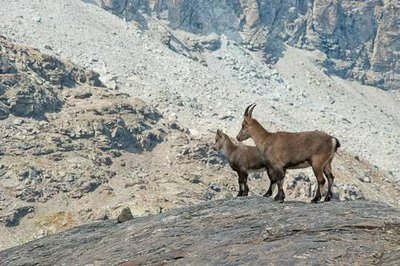
Etagne et cabri de bouquetin sur une dalle rocheuse. Près du Lac d'Ambin, Bramans. - PNV - BEURIER Mathieu  Fauna
FaunaThe ibex nursery
Take the time to examine in detail the austere and steep rocks that surround the valley like a wall. And for good reason, this dangerous setting is the site of a nursery that few mothers of the animal kingdom would take comfort from! Ÿet this is the place where the female ibexes, the étagnes, choose to give birth to their offspring in June and to raise them throughout the summer. What a splendid sight it is to see the young kids gathered together in small groups frolicking and playing on the treacherous cliffs, under the calm eye of their mothers! Here, these sturdy climbers in the making will have little to fear from predators.
